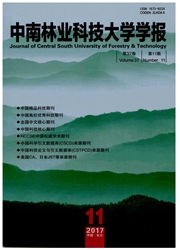

 中文摘要:
中文摘要:
为探明无机镁系化合物对木质材料的阻燃效果及特性,采用锥形量热fCONE)和热重-示差扫描量热法分析了经3种重要无机镁系化合物——氢氧化镁、氯化镁和碱式碳酸镁处理木粉的燃烧性能、发烟性能和成炭特性。结果表明:3种镁系化合物均明显降低木材的热释放速率(HRR)和总烟释放量(TSP),表现出良好的阻燃抑烟效果;3种镁系化合物通过不同机理阻滞木材燃烧,氢氧化镁在木材开始大量热解温度附近脱水并在木材表面生成熔融物而产生阻燃作用,氯化镁在凝聚相和气相阻燃,碱式碳酸镁部分分解为不燃气体抑制木材燃烧;碱式碳酸镁与氯化镁对木材具有协同阻燃抑烟效果。
 英文摘要:
英文摘要:
In order to explore the flame-retardation effects and characteristics of inorganic magnesium compounds as wood fire-retardant, cone calorimeter(CONE) and thermal gravity--differential scanning calorimeter analyzer(TG-DSC) were used to analyze the combustion properties, smoke-release properties, and carbonization characteristics of wood powder treated by three important inorganic magnesium compounds--magnesium hydroxide, hydrated magnesium chloride, and basic magnesium carbonate. Results showed that: all of thesethree magnesium compounds could reduce the heat release rate(HRR) and total smoke production(TSP) of wood, showing good flame- retardation and smoke-suppression effects. Three magnesium compounds exert their flame-retardation effects by different mechanism:magnesium hydroxide could release moisture at a time when wood is going to drastically pyrolyze, and produce melts to protect wood; hydrated magnesium chloride could retard or put out fire at both the solid stage and the gas stage; basic magnesium carbonate protects wood from fire by releasing incombustible gas; basic magnesium carbonate and hydrated magnesium chloride have synergistic flame- retardation and smoke-suppression effects.
 同期刊论文项目
同期刊论文项目
 同项目期刊论文
同项目期刊论文
 Comparative Performance of Three Magnesium Compounds on Thermal Degradation Behavior of Red Gum Wood
Comparative Performance of Three Magnesium Compounds on Thermal Degradation Behavior of Red Gum Wood Flame retardancy and thermal degradation behavior of red gum wood treated with hydrate magnesium chl
Flame retardancy and thermal degradation behavior of red gum wood treated with hydrate magnesium chl Manipulation of the phase structure of vinyl-functionalized phenylene bridging periodic mesoporous o
Manipulation of the phase structure of vinyl-functionalized phenylene bridging periodic mesoporous o 期刊信息
期刊信息
